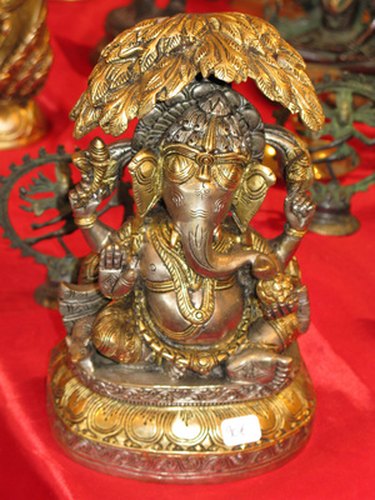
Investment compounds are materials that generally come in powder or concentrated forms, then are mixed with water to create liquid molds that harden around the wax models of sculptures. The wax is then burnt out to allow molten metal to be poured in. Bronze casting investments require material that is strong and heat-resistant, yet delicate enough to pick up the finest detail. Because of this, many sculptors use a two-step investment process, coating the model with a fine investment to pick up the detail, then submerging that into a rough, or coarse, investment to add strength and heat resistance.
Fine Investment
Video of the Day
Plaster of Paris is the standard investment for jewelry casting because it is excellent at conforming to fine detail when applied in a liquid state, and it is cheaper than specialized commercial investments. To get the best results with plaster, measure out the water called for by the amount of investment you need to mix, then allow it to reach 70 to 72 degrees. Instead of measuring the plaster, use a flour sifter to sift the plaster powder into the water. Do not stir the mixture; instead, avoid jostling it at all as you continue sifting in the powder, watching the edges of the hill of powder that forms. Note when the water stops absorbing into the plaster and crumbling it off at the edges. At this stage, your mixture has "peaked," and is the appropriate proportion.
Video of the Day
Mix the plaster investment quickly but gently with glove-coated fingers, feeling for lumps and breaking them up. As soon as it starts to thicken, flick plaster onto your sculpture by dipping your fingers into the mixing bowl and flicking them at the model. This drives the plaster into crevices while also using the velocity of impact with your model to drive any air out. Coat your entire model in this manner until the plaster is approximately 1/4-inch thick.
Rough Investment
Rough investments should be stronger than plaster of Paris to avoid cracking due to the temperature of molten bronze. Many sculptors recommend mixing plaster and sand, but the sand often interferes with the plaster's ability to set up properly. Instead, try mixing equal parts plaster, sand and clay powder, which you can generally find at or order through art supply stores. The addition of the silicates in clay creates a stronger investment that holds up to heat. Mix an experimental batch with equal parts of the plaster, sand, clay and water. Check the texture of the investment when it dries, and add more water if it cracks or less water if it doesn't fully set.